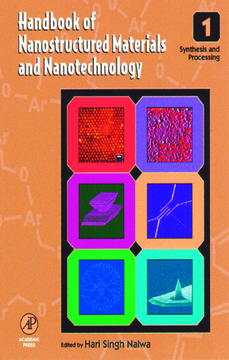
BOOK
Handbook of Nanostructured Materials and Nanotechnology, Five-Volume Set
(1999)
Additional Information
Book Details
Abstract
Nanostructured materials is one of the hottest and fastest growing areas in today's materials science field, along with the related field of solid state physics. Nanostructured materials and their based technologies have opened up exciting new possibilites for future applications in a number of areas including aerospace, automotive, x-ray technology, batteries, sensors, color imaging, printing, computer chips, medical implants, pharmacy, and cosmetics.
The ability to change properties on the atomic level promises a revolution in many realms of science and technology. Thus, this book details the high level of activity and significant findings are available for those involved in research and development in the field. It also covers industrial findings and corporate support. This five-volume set summarizes fundamentals of nano-science in a comprehensive way. The contributors enlisted by the editor are at elite institutions worldwide.
Key Features
* Provides comprehensive coverage of the dominant technology of the 21st century
* Written by 127 authors from 16 countries, making this truly international
* First and only reference to cover all aspects of nanostructured materials and nanotechnology
"Nanotechnology, with its multidisciplinary nature and numerous potential applications, may be one of the most difficult fields in which to stay informed. Such a new area would typically have to wait several years for a disciplined, well-organized survey to appear, but Hari Singh Nalwa has already compiled a five-volume overview, Handbook of Nanostructured Materials and Nanotechnology....The contributors have exerted considerable effort to include introductory material that will benefit readers who are crossing disciplinary lines. Anyone interested in learning how these materials can be made, how they can be characterized, and what they can and might be able to do will likely be well served by this reference."
- Phillip D. Szuromi, Science
